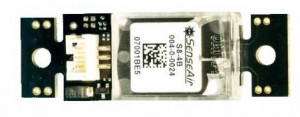| SenseAir |

| Registration Date | 5 Oct 2016 |
| Share |
Environment Air Remediation
Environmental Sensor- Public safety - Energy saving - Reduced costs - Environmental savings - Good indoor air quality -Miniature size -Individually calibrated -Maintenance-free -Long term stability -Low power consumption
SenseAir® S8-4B is a miniature low power LNE approved safety switch. SenseAir® S8-4B main application area is to serve as a CO2 safety switch when built into equipment such as kerosene heaters and other equipment generating potential hazardous levels of CO2 gas. Because of low current consumption the sensor is suitable for battery applications and has an average current consumption of 2 mA.
With CO2 measuring it is possible to control individual fans, dampers, valves, etc., which create a better indoor environment and energy savings. A common application is controlling ventilation in rooms with varying numbers of people such as offices, classrooms, and cinemas. The ventilation control is based on temperature and CO2.
The primary indoor source of CO2 in office buildings is the breathing of the building occupants. CO2 concentration in office buildings typically ranges from 390 to 2500 ppm. Today there are laws about measuring the CO and the maximum allowed value is 35 ppm. Rules about measuring the CO2 do not exist even if it's equally as important. It is therefore useful to measure both gases to ensure personal safety. The Threshold Limit Value for 8-hour timeweighted-average exposures to CO2 is 5 000 ppm. The current American Society of Heating, Refrigeration, and Air-conditioning Engineers (ASHRAE) recommended minimum ventilation rate for offices is 10 L/s per person, corresponding to an approximate steady state indoor concentration of 910 ppm, based on the assumptions that outdoor CO2 is 390 ppm and indoor CO2 generation rate is 0.31 L/minperson. Sick Building Syndrome (SBS) is used to describe a set of symptoms with unidentified etiology frequently reported by workers in office buildings. The individuals who suffer from SBS report that the symptoms occur when they spend time indoors, particularly in office buildings and that the symptoms lessen while away from the building. In order to have optimum ventilation it is important to use an affordable and stable sensor technology to measure CO2 concentrations to determine the correct level of fresh air in a zone. Proper CO2 measurements in a space make it possible to control the level depending on the person's air circulation at any given moment. The sensor controls the need of fresh air in individual spaces and then sends a signal to a computer that controls the main ventilation system. Complete air-handling and air-conditioning units help us create a better indoor environment as well as obviuos energy savings.